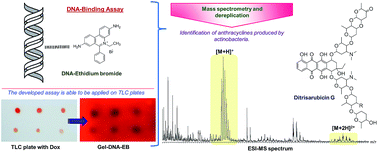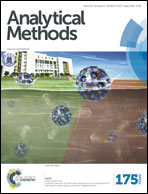DNA–EB in agarose gel assay: a simple methodology in the search for DNA-binders in crude extracts from actinomycetes†
Abstract
DNA is known as a potential therapeutic target for the development of anticancer and antibiotic agents because any damage on its structure may lead to cell death. Discovery of ligand molecules through interactions with DNA is a key step in the development of new therapies. Here, a methodology was proposed to detect DNA-binders in a screening process with crude extracts produced by actinomycetes. This assay consists of a DNA–EB (ethidium bromide) complex added previously, into a simple agarose gel, where EB may be replaced by other metabolites, present in the sample added before over the gel. The free dye is washed and, consequently, the fluorescence intensity decreases. The assay results were recorded by photographs and the fluorescence intensity was transposed in pixel values using Image J software, allowing statistical analyses. The developed assay can also be applied directly onto TLC plates. Sixteen crude extracts produced by actinomycetes were screened using the developed assay, in which four crude extracts showed a significant fluorescence decrease. Dereplication studies with mass spectra data allowed the identification of anthracyclines such as Ditrisarubicin F and G in one of the selected extracts. The methodology developed here is a promising approach for drug discovery because it may lead to the detection of DNA-binding compounds in a simple, low cost way and without isolation and/or purification processes.


 Please wait while we load your content...
Please wait while we load your content...